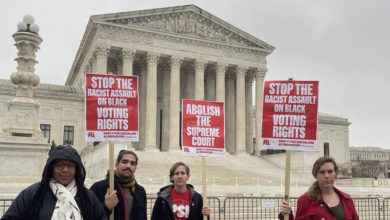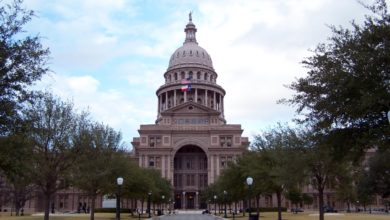NEW: Listen to this article.
In the span of one week the political calculus of the Democratic primary has shifted dramatically. A week ago Biden was falling in national polls, discussed as a third or fourth place candidate, and Bernie Sanders was considered the front runner with the clearest road to victory. All of Sanders’ opponents, representing different factions within the establishment, were at each other’s throats, giving space for the left-populist movement to momentarily ascend to first place. Now, the situation is vastly different. The media is again covering Biden as the front runner, if not the presumptive nominee, the other establishment contenders have dropped out and Sanders has returned to his role as the underdog with a slimmer pathway to the nomination.
It is important that all class conscious workers and progressive people understand how this turn of events transpired, and so quickly, and not accept the corporate-owned media’s narrative. It has all happened so fast — like a magician’s sleight of hand — that it is easy to have one’s attention diverted from the main story.
Among their many distortions, the dominant ruling-class narrative after Super Tuesday is that a) Bernie Sanders’ campaign has been proven to be too far left to resonate with a broad electorate, b) that Biden has somehow, miraculously, transformed his candidacy overnight into something impressive in the eyes of the Democratic base, c) African American voters are especially “moderate” and therefore drawn to Biden’s message, and d) that Biden is widely understood as the most “electable” against Trump.
All of this is false. Here are four reasons to challenge these claims.
Point 1: Biden owes his resurgence first and foremost to a unity among broad sections of the ruling class
Biden has emerged as the front-runner for one and only reason: the ruling class united behind him as the best instrument to stop the Bernie Sanders movement. Biden is no more coherent, gifted or impressive as a candidate today than he was a week ago when he was consistently polling in third or fourth place and racking up headlines for embarrassing gaffes.
But of the available ruling-class options, when push came to shove, Biden was the only one with the name recognition and the connection to Barack Obama (the only Democratic establishment figure with genuine popularity) to potentially beat Sanders. Biden had been cast as the front-runner for much of 2019. But he had so many clear vulnerabilities — as an individual, as a public speaker, as a long-time ally of the racist right-wing and as a living embodiment of mediocrity and the Washington establishment — that it created deep anxiety among the ultra-rich and donor class about his viability to excite Democratic voters, to win the election and function as the next CEO of U.S. imperialism on a world stage. All of their concerns became painstakingly clear whenever he campaigned and debated, or generally opened his mouth.
So different sections of the ruling class and the Democratic Party pitched their alternatives to Biden. But in the end none of these campaigns alone could compete with the breadth and fervor of the Sanders movement. They needed to consolidate. When the critical moment of Super Tuesday arrived, looking at the possibility of a runaway Sanders’ victory, the ultra-rich put aside their anxieties and differences — whether by persuasion, bribery, or cajoling — and united. Buttigieg and Klobuchar jumped on planes to go back up Biden at campaign events on the final day.
The consolidation of the ruling-class was immediately reflected in the corporate media. Just about every news station broadcast a narrative of Biden’s new and seemingly unstoppable momentum. Rather than focus on his program or his inspirational qualities, both of which are non-existent, they focused exclusively on Biden’s supposed “electability” against Donald Trump, especially compared to Sanders “the socialist.”
The Democratic Party machinery and networks had finally received their clear message about who was “the guy” for 2020. That machinery, well-practiced and refined in whipping votes and endorsements, had been paralyzed by a year of in-fighting among the party’s highest ranks and donor class. That’s what had given Sanders such a big opening and created a sense of momentary jubilation among the Sanders movement that he might be able to win quickly. But the truth is that the ruling-class clique that dominates the Democratic Party apparatus had been preparing too. They were not going to let Sanders run away with Super Tuesday on account of a crowded primary and had planned behind-the-scenes interventions to prevent that; Obama himself had said as much. So they made the calls and the machinery jumped into action.
The financiers on Wall Street immediately followed. As the New York Times headline read, “Wall Street, Encouraged by Biden’s Wins, Breaks Out Its Checkbooks.” Up until now Biden has struggled to fundraise. The billionaire Michael Bloomberg got the message too, dropping out immediately and endorsing Biden; he is now expected to turn over his vast resources and campaign apparatus to Biden and the Democratic establishment.
If there was a slogan to summarize the political moment after Super Tuesday, it would be “Imperialists, oligarchs and Wall Street investors, unite!”
While the Democratic Party ballot line may be technically open for insurgent candidates to contend, there are powerful forces who wield the Democratic apparatus to defend ruling class interests. Any illusions about that apparatus being transformable have again been dispelled.
Point 2: Large sections of the U.S. ruling class would prefer a Trump victory over a Sanders victory
All the renewed messaging about Biden’s “electability” is just fluff. The Democratic Party establishment’s concerns about whether Biden can endure a presidential campaign, inspire voter turnout and defeat Trump are well-founded.
Biden has been a spectacular failure at running for president since 1988 and after 30 years of tanking in the primaries, scored his first ever primary victory in South Carolina last Saturday. This is not exactly a born winner, as all the experienced political hands among the ruling class know. They’re also fully aware of the litany of polls for head-to-head contests showing that Trump would lose to Sanders by greater margins than he would to Biden. They’re fully aware that Sanders had more crossover appeal to Republican and independent voters than did Hillary Clinton, and that Sanders remains the most popular U.S. politician regardless of party. The “Biden is more electable” argument is not based on any statistics.
In fact, a Biden win will lead large numbers of Sanders supporters — arguably the most energetic sector of Democratic voters — to stay home in November.
This reveals a deeper, darker secret that few Democratic Party establishment leaders will admit — they’d prefer a Trump re-election over a Sanders presidency. A Sanders presidency would unleash social forces and political contradictions that would be very difficult for the neoliberal party establishment to manage. It would cause challenges and disruptions to major financial interest groups.
Notably, insurance company stocks plummeted when Sanders won Nevada; upon the news of Biden’s Super Tuesday victories, they then surged upwards along with the whole stock market. It was not just Coronavirus that was spooking the market; it was the potential of a Sanders win.
For the Democratic establishment, remaining in pseudo-opposition to Trump is far more preferable, where they can stage public relations stunts to appear progressive and raise money for their campaigns, while doing very little. Being against Trump is easy, a low bar.
Point 3: The core Democratic Party base in the South, including Black voters, are also moving to the left politically — just like Democrats elsewhere — and embrace much of the social-democratic program. But that core, especially older voters, remains outside of the Sanders movement and more integrated into the Democratic Party machinery.
The corporate media’s stereotyping of Democrats in the South, and the Black vote in particular, as immovably “moderate” is pernicious because it can be repeated by well-intentioned people on the left, if they have little direct knowledge of politics in the South.
Sanders did come in first among young Black voters in the South, and lost by large margins among those over 55 years old. There is no single explanation for this generational divide, which is playing out among all communities, not just the Black community. Clearly, there is a growing openness to socialism and more radical policies among young people generally, who are particularly attracted to the Sanders campaign’s ambitious and bolder messaging.
But the generational divide should not be misunderstood. The considerable gap in voting preferences — Biden or Sanders — does not suggest there is an unbridgeable gap in the belief systems between generations.
Polls taken right before Super Tuesday, with anti-socialist rhetoric flooding the airwaves, showed that “socialism” was viewed favorably by a wide margin of Democratic voters in Texas (57 to 37 percent), wider even than Democrats in California. Socialism was also favored among Democrats in North Carolina and Tennessee.
Of the Texas Democrats who view socialism favorably, 36 percent of them voted for Biden or Bloomberg. An Alabama exit poll found that 51 percent of Democratic voters support ‘Medicare for All’ instead of private insurance, but even among those ‘Medicare for All’ supporters Biden defeated Sanders by 23 points. In Tennessee, 73 percent of Democratic voters said public colleges should be tuition free — a sector that Biden still won by 10 percent over Sanders. In South Carolina, 53 percent of Democratic voters marked down that the U.S. economic system “needs a complete overhaul” in an NBC exit poll.
Clearly there are many older Democrats in the South who actually agree with Sanders’ core policies — may even prefer them to Biden’s — but still tactically voted for Biden. Some have understandably lower expectations about what the government can deliver given the decades of broken promises, and are less moved by Sanders’ grand designs; many have a dimmer view, from inside the “red states,” of whether Sanders is electable; many voters are inclined to stick with the “devil you know.” And of course, there’s the familiarity with Biden as Obama’s Vice-President.
The main difference between young and older voters, however, is forms of organization. Many older Black voters in the South are a part of long-standing community organizations like churches and other civic and local institutions. When activated, these can result in disproportionately higher turnout. But younger voters of all races are less integrated into such networks, and therefore less influenced by them on Election Day. So there is more political “free agency” among young voters, and likewise a far smaller turnout. Sanders also is challenged by the fact that poor people and young people of all races historically have far lower turnout numbers in primaries and many are rightfully not convinced that the Democratic Party can be a vehicle for transformational change, even if they like Sanders’ message.
Point 4: A huge number of people in the United States are voting for a self-avowed “socialist” and are defying all the “conventional wisdom” telling them to be afraid of and hate socialism. This is a tremendous opportunity for the left.
For class-conscious workers and socialists, the most important issue with the Sanders campaign is not how we understand Sanders the individual, although that is pivotal too. As a long-standing Washington politician, Sanders is somewhat of an accidental figure. What is most important at this stage is that his campaign has emerged as an instrument and provided a path of least resistance to raise the expectations of the working class, introduce important socialist-oriented reforms into popular discourse and sharpen consciousness around the reality of class division in this country.
Sanders himself gives a muddled and watered-down definition to socialism, and tries to gain bourgeois respectability by distancing himself from real socialist and anti-imperialist traditions (and he still gets criticized for not condemning Cuba enough!) This too is an opportunity for socialist organizers to provide clarity, education and organization to those becoming interested in socialism.
Bernie Sanders is currently steering a resurgent grassroots movement for social change in the United States. He is facilitating its growth by maintaining a clear and unwavering set of policy proposals in the face of nonstop attacks. Those policies would not be considered radical for much of the world, or even for the New Deal era of the Democratic Party, but they had been vanquished decades ago by the ruling class bipartisan consensus. Sanders’s leadership of this movement will soon be tested as major struggles lie ahead. The primaries are far from over and the delegate count remains close. If Sanders is deprived of the nomination, and this time with a potential delegate lead, and with Biden or another neoliberal taking it by backroom deals, will he still carry out his pledge to support that nominee? Will he consider an independent run? Will his supporters carry through the “Bernie or Bust” slogan despite his pleas and will the Democratic National Convention become the site of major struggle and potential splits?
Despite the surge in left-wing attitudes and ideas, the structure of U.S. politics pushes things continuously towards lesser-evil political decisions — towards voting as a form of “harm reduction” rather than an accurate barometer of political beliefs. But this contradiction cannot be suppressed forever, and will sooner or later explode.





